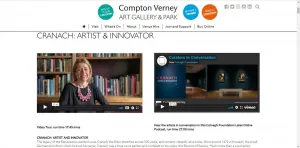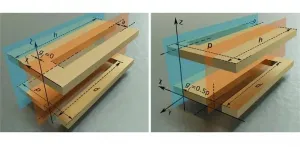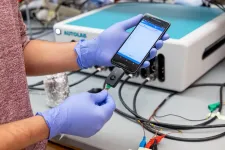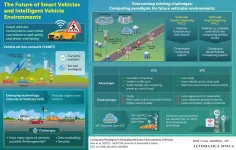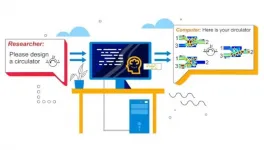(Press-News.org) When Museums closed their doors in March 2020 for the first COVID-19 lockdown in the UK a majority moved their activities online to keep their audiences interested. Researchers from WMG, University of Warwick have worked with OUMNH, to analyse the success of the exhibitions, and say the way Museums operate will change forever.Caption: Compton Verney's homepage for the Cranach exhibition which opened in March 2020 Credit: Compton Verney
The cultural impact of the COVID-19 pandemic has been analysed by researchers from WMG, University of Warwick in collaboration with OUMNH (Oxford University Museum of Natural History) who in the paper, 'Digital Responses of UK Museum Exhibition to the COVID-19 Crisis March-June 2020' published in the journal Curator: The Museum Journal, have analysed the success of online museum exhibitions, and investigated what the future of Museums holds.
Researchers analysed 21 museums who had temporary exhibitions due to open between March and June 2020, and decided to go ahead with the exhibition virtually. The analysis included noting how COVID was considered, how content was presented, and discussing themes of access, embodiment, and human connection.
The research team found that in May-June Museums had more online content for their exhibitions, suggesting there was time to prepare the transfer of exhibition online. All exhibitions were different, with some hosting podcasts, some doing filmed walk-arounds and some hosting a virtual room where you click on exhibits.
Although digital exhibitions were a success, researchers concluded online exhibitions do not provide the same social and embodied experience as the physical museum, as you miss the travelling there, welcome from staff, chatting with other visitors and the gift shop or coffee shop after.
They did however highlight that extra material was provided for online content which isn't traditionally presented in the Museum, this included behind the scenes videos for example. Researchers say this suggests Museums were trying to give their audiences some exclusives that they would not receive from a normal visit.
Lead author, PhD Student Ellie King from WMG, University of Warwick comments:
"The COVID-19 lockdowns have created a crucial turning point in the Museum sector, as they now see themselves working in a physical-digital overlap. It is interesting to note how in being forced to shut, museums focused their online provisions around existing physical exhibitions.
"Museums and galleries will continue to adapt in light of a post?COVID world where practices, both digital and physical, will undoubtedly shift. It is important to see the digital exhibition world as an opportunity to provide unseen materials and attract audiences who may not be able to visit in person."
Although it's likely there will be more online material generated by Museums and galleries from now on due to the pandemic, there is the issue of staff having the digital skills to manage a new arena of engagement.
Professor Mark Williams, from WMG, University of Warwick explains:
"One of the major tasks of converting to online is the financial implications, 30% of museums have changed staff tasks to provide services online. Despite this, there are concerns that staff teams are not fully equipped to handle such monumental changes.
"This highlights the practical challenge of enabling the rise of digital content for museums, which will be dif?cult for the sector in such a stretched resource environment."
Professor Paul Smith, Director at the Oxford Museum of Natural History adds:
"The first COVID-19 lockdown imposed a real-time stress test on museums, and their ability to respond in an agile way to events. The paper highlights the creative ways in which some museums were able to adapt to the unique and unprecedented circumstances they faced."
This research is part of a wider interest of the CiMAT team in WMG to engage with subject areas beyond engineering. Based on previous research into User Experience, the research group is seeking to apply concepts into areas of the arts and humanities. The research has blossomed with the collaboration between WMG and Oxford University Museum of Natural History. This research, which analyses how visitors experience museums online, is a welcome starting point. The researchers stress to Museums that with this rising atmosphere of change on the horizon, it is important they consider such conceptual issues and evaluate audience needs rigorously when developing online offerings to maintain such cultural importance.
INFORMATION:
An international research team led by the University of Cologne has succeeded for the first time in connecting several atomically precise nanoribbons made of graphene, a modification of carbon, to form complex structures. The scientists have synthesized and spectroscopically characterized nanoribbon heterojunctions. They then were able to integrate the heterojunctions into an electronic component. In this way, they have created a novel sensor that is highly sensitive to atoms and molecules. The results of their research have been published under the title 'Tunneling current modulation in atomically precise graphene nanoribbon heterojunctions' in Nature Communications. The work was carried out in close cooperation between the Institute for ...
BOSTON - (May 12, 2021) - Scientists are rapidly gathering evidence that variants of gut microbiomes, the collections of bacteria and other microbes in our digestive systems, may play harmful roles in diabetes and other diseases. Now Joslin Diabetes Center scientists have found dramatic differences between gut microbiomes from ancient North American peoples and modern microbiomes, offering new evidence on how these microbes may evolve with different diets.
The scientists analyzed microbial DNA found in indigenous human paleofeces (desiccated excrement) from unusually dry caves in Utah and northern Mexico with extremely ...
Surface plasmon polaritons (SPPs) are highly localized surface waves on the interface between metal and dielectric in the optical frequency band. SSPs do not naturally exist in the microwave and terahertz frequencies, so "spoof" surface plasmon polaritons (SSPPs) are necessary for operations in those lower frequency bands.
Like optical SPPs, microwave SSPPs exhibit highly localized electromagnetic fields, subwavelength resolution, and extraordinary field confinement. Therefore, SSPP transmission lines (TLs) have been proposed as novel types of microwaveguides that offer new solutions for miniaturization, ...
BOSTON - During the development and progression of Alzheimer's disease, a protein called tau accumulates and spreads in the brain. Understanding the mechanisms behind tau spread--and its consequences--may point to new prevention and treatment strategies for Alzheimer's disease and other forms of dementia. New insights now come from research that was led by investigators at Massachusetts General Hospital (MGH) and involves an anesthetic known to affect cognitive function. The findings are published in Communications Biology.
The scientists note that inflammation plays an important role in Alzheimer's disease, and microglia--immune cells that reside in the brain--are thought to be involved in this process by producing an ...
Since the discovery of Alzheimer's disease over a century ago, two hallmarks of the devastating illness have taken center stage.
The first, known as amyloid plaques, are dense accumulations of misfolded amyloid protein, occurring in the spaces between nerve cells. Most efforts to halt the advance of Alzheimer's disease have targeted amyloid protein plaques. To date, all have met dispiriting failure.
The second classic trait has, until recently, received less scrutiny. It consists of string-like formations within the bodies of neurons, produced by another crucial protein-- tau. These are known as neurofibrillary tangles.
In a new study, researchers with the ASU-Banner Neurodegenerative Disease Center at the Biodesign ...
PHILADELPHIA--A low-cost, rapid diagnostic test for COVID-19 developed by Penn Medicine provides COVID-19 results within four minutes with 90 percent accuracy. A paper published this week in Matter details the fast and inexpensive diagnostic test, called RAPID 1.0 (Real-time Accurate Portable Impedimetric Detection prototype 1.0). Compared to existing methods for COVID-19 detection, RAPID is inexpensive and highly scalable, allowing the production of millions of units per week.
Despite the urgency of the pandemic, most available methods for COVID-19 testing use RT-PCR--reverse transcription polymerase chain reaction--to detect ...
Central to any technological progress is the enrichment of human life. The internet and wireless connectivity have done that by allowing not only virtually anyone anywhere to connect real time, but by making possible connections between humans and a range of intelligent devices both indoors and outdoors, putting smart cities on the horizon.
One key aspect of realizing smart cities is "smart vehicles", the latest development in intelligent transportation systems (ITS), which involve the integration of communication, mapping, positioning, network, and sensor technologies to ensure cooperative, efficient, intelligent, safe, and economical transportation.
For decades, research on bringing to the streets smart vehicles that operate ...
The field of magnonics offers a new type of low-power information processing, in which magnons, the quanta of spin waves, carry and process data instead of electrons. The end goal of this field is to create magnonic circuits, which would be smaller and more energy-efficient than current electronic ones.
Until recently, the development of a functional magnonic device could take years of trial-and-error. Researchers from the University of Vienna and the TU Kaiserslautern have developed a new computational method to design new devices in a considerably shorter time. Moreover, the efficiency added through this novel inverse design method helps overcome a traditional problem with such devices: they were just suitable for one function only. Now, thanks to the proposed ...
The inhibition of pathological protein-protein interactions is a promising approach for treating a large number of diseases, including many forms of cancer. A team of researchers has now developed a bicyclic peptide that binds to beta-catenin--a protein associated with certain types of tumor. The secret of their success is the cyclic nature and the hairpin shape of the peptide, which mimics a natural protein structure, they report in the journal Angewandte Chemie.
Because of the extensive protein regions involved in protein-protein interactions, therapeutic approaches involving small molecules are often unsuccessful. Protein mimetics are alternatives that imitate the spatial structure of binding segments of natural protein binding partners. ...
In a new study from Lund University and the University of Gothenburg, patients were interviewed about their experiences ten years after undergoing obesity surgery. The results show that the effect on eating and weight regulation persisted, whereas other problems, such as feelings of guilt about still not being healthy enough, remained.
"This is one of few follow-ups from a patients perspective so long after surgery", says My Engström, researcher in nursing at the University of Gothenburg.
18 patients were interviewed in the study. All of them experienced that their eating habits and appetite were still affected after the operation: their bodies still objected, preventing ...
